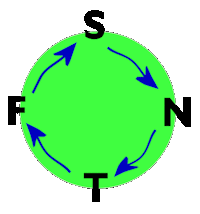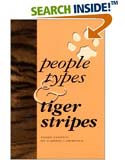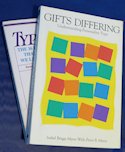
- About the MBTI
- Verify Your MBTI Type
- Personality Patterns
- MBTI Articles & Resources
- Article Directory for Educators & Students
- Books on Personality Types
- Emotional Intelligence & Personality Type
- Career Planning & MBTI
- MBTI Business Applications
- Lenore Thomson - Carl Jung Personality Type
- Site Map - Master Directory of All Articles
- MBTI Consultant Links
- Personality Type Workshops & Conferences
- Links to Other Type Websites
- Murder Mystery Business Theatre
- About Us
![]() Zig-Zag Problem Solving Model
Zig-Zag Problem Solving Model
By Ross Reinhold, INTJ
Initially developed by Isabel Myers, this useful technique has been adapted by others, including Gordon Lawrence, an educator who applied the Myers MBTI ® model to his field of endeavor.
The following summary owes gratitude to:
Introduction to Type, Fourth Edition, 1987 by Isabel Briggs Myers, Allan Hammer, editor
People Types & Tiger Stripes, Third Edition, 1993 by Gordon Lawrence
Myers found people tended to more heavily employ their most favorite preferences in making decisions and solving problems. We 'see' the world through these lenses and react accordingly.
For a person whose dominant preference is "Thinking" it is awful difficult not to caste any decision or problem situation in the light of logic. Conversely, a dominant "Feeling" preference person will experience and react to an entirely different set of impressions - weighing emotional, subjective, and people-oriented implications.
Conventional Wisdom (and Dorothy of Wizard fame) would urge the Thinking preference person to get a "heart" and the Feeling preference person to get a "brain" (be logical)! Setting aside the offensive aspect of these notions, actually attempting to make such a conversion can lead to compromising the source of one's strengths in the interest of acquiring a modicum of sensitivity in the opposite arena. Net result: zero at best.
Instead of falling into this trap, Myers (1987) felt that all types - regardless of favored preference - would benefit by following a systematic process that involved the exercise of all 4 preferences.
"Whenever you have a problem to solve, a decision to make, or a situation to deal with, try exercising each process by itself--consciously and purposefully. That way each process can make its own contribution to the solution without interference from any other process. Start with your perceptive processes (sensing and intuition). Perception should always come before judgment."
Lawrence (1993) pictured this process as a Zigzag through the preferences, beginning with Sensing and ending with Feeling.
   |
 |
   |
Step 1. We begin with Sensing to discover "what is." What do we know for sure? (just the facts, ma'am!) What is the situation - exactly? What has gone before? Who is involved? Collect the data, keeping an open mind uncolored by sentiment or leaping to conclusions.
Step 2. Then use Intuition to speculate on patterns and connections formed by the facts. What are the possibilities? What solutions tend to jump out from what is known? Do some brainstorming on ideas. Develop a range of alternatives - without critically analyzing them at this stage.
Step 3. Once Intuition has been allowed to flower, it is Thinking's turn at the wheel. Subject the product of the Intuitive & Sensing phases to an objective analysis, weighing facts against speculations. Use logic to determine cause and effect. Draw distinctions, weigh and rank the pros and cons, quantify your conclusions.
Step 4. End the first cycle of the process by utilizing Feeling judgment to incorporate the human consequences: the impact on people, the impact on values and sensibilities, and all the emotional components. In addition acknowledge the subjective elements affecting those involved in the analysis or the making of the decision.
Step 5 and beyond. Recyle the steps when needed.

While Lawrence and others might imply the above four step process ends with Feeling considerations, I prefer to look at it as the rim of a wheel that may be traveled several times before arriving at a satisfactory conclusion. For example, the last step of the first cycle may identify people or feeling elements that are actually part of the FACTS of the situation - but were simply not recognized during the initial Sensing Fact Finding step. So this requires a return to the beginning, restating the nature of the problem or decision situation and then proceeding again through N and T.
The nature of a situation itself may require more intense participation of one or more of the four steps. There are situations whose gravity requires the utmost in logical analysis - where a mistake could have dire consequences. There are situations with clear implications to human values where the most considered and human sensitive input is essential. There are situations where a high premium is placed on creative, out-of-the-box thinking. But in all these cases, the S-N-T-F cycle ought to be followed - at least once around the block - before settling on what may require more extended concentration.
![]() From Practical Applications of Personality Type
From Practical Applications of Personality Type
® Myers-Briggs Type Indicator ® and MBTI ® are registered trademarks of CPP, Inc
(Consulting Psychologists Press, Inc.)
The MBTI Personality Type of Donald Trump - looking behind the media mask of The Donald.
 People Types and Tiger Stripes
People Types and Tiger Stripes
Gordon Lawrence's book is mandatory reading for any educator, teacher or trainer interested in using an understanding of Myers-Briggs Personality Type to improve their effectiveness. Because Lawrence practiced what he preached, this book is organized in a fashion that is easy read for "all personality types." it also does a nice job of including both introductory material on understanding Personality Types and extensive material on applications to the classroom and learning environment. It is jam packed full of useful advice. [Ordering Info Here]
© Published by Ross Reinhold & Reinhold Development 1997 - 2023
Privacy Policy About Us

